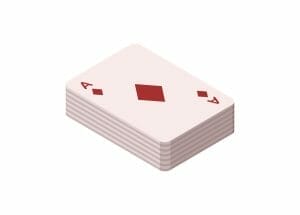My all-time favorite book on sales, High Probability Selling, contains one of the BEST pieces of sales advice anyone could ever hear:

Suppose I give you a deck of cards, face down, and tell you I’ll give you five dollars for every ace you find in the next two minutes. The only rule is that you can’t pick up the entire deck and sort through them all at once. You can only find the aces by flipping the top card over, one at a time. You agree to play, and the timer starts. Suppose the first card you turn over is a six of hearts. How much time would you spend trying to convince me it’s an ace?
Some would argue that the smart salesperson would stack the deck with all aces – but how exactly do you do that? The problem is prospects don’t always need or want what we’re selling now. So “aces” change into sixes all the time, and some sixes will suddenly become an ace. They get a ransomware attack. Their IT company goes out of business, or their IT lead quits. They finally get to the point of threshold and decide enough is enough when their doofus IT company fails to fix the damned printer problem again.
There’s not a Batphone that suddenly rings and says, “THIS guy is now an ACE!”

That’s why salespeople need to dedicate a portion of their day to constantly prospecting and keeping that pipeline full. You want to find the aces in the deck who HAVE a need and are looking to make a decision in the near future. Yes, use Pay-Per-Click and SEO to get in the way of those prospects actively seeking you – but the flaw in that strategy alone is that 1) not everyone goes online to search when they start thinking of replacing a vendor…they start getting ready to buy slowly, over time and may ask their friends and colleagues who they use, cutting you out of the opportunity altogether, and 2) prospects who are living in a “zone of dissatisfaction” might not be ACTIVELY looking just yet but would be open to a conversation, a competitive bid and looking at an alternative.
Of course, nobody likes putting in the reps or the work.
To circumvent the work of prospecting, salespeople (and business owners) seek to find the proverbial “perfect” list of prospects to call. The unicorns that will answer your phone call before the second ring, be happy you called them, and instantly want to book an appointment to buy what you’re selling. The aces in the deck.
So they sit at their desk and research, read, ponder, think, look around, etc., wasting HOURS trying to determine if the prospect they have in front of them is the “right” one to call when all they had to do was pick up the phone to find out in an instant. Besides, if we could somehow get our hands on that list of “ready to buy now” buyers who would ALSO take our call, we as business owners wouldn’t need to hire SALESPEOPLE. We could give the list to an untrained monkey and be productive.
To make matters worse, everyone wants the “hack” to trick someone and get in the door fast.
Here are some examples of the best-selling book titles on selling: The Sales Advantage: How to Get It, Keep It, And Sell More Than Ever; $100M Offers: How To Make Offers So Good, People Feel Stupid Saying No; or Exactly What To Say: The Magic Words For Influence And Impact. You get the idea.
Nobody wants to read the book Grinding Out 100 Dials A Day For A Month To Find 1 Maybe. Yet one of the biggest reasons salespeople fail is that they don’t prospect to a sufficient number of people. They don’t understand the importance of VOLUME. I’m all for being STRATEGIC, and I’m not suggesting you just start calling anyone and saying anything. But at some point, you have to stop with all the overthinking and preparation and just pick up the phone and DIAL!

You give me a sales rep who spends most of his day working to find the “magic beans” of what to say to a prospect that will instantly flip them into a buyer, using an NLP “hack” or tricks like “Do you have 26 seconds…,” making only a few calls a day, and put him against a guy with a good script, no “tricks” or gimmicks, a good process and a good list, a guy who will crank out 100 to 150 dials a day, and the dude making the VOLUME of calls will win every time.
In our company, we know that a rep can make 25 dials an hour easily.
That’s average. Someone hustling can make more. One hundred dials a day takes four hours which is just 50% of an eight-hour day. So, if you have a rep who isn’t cranking the dials, you’ve got a dud with a limited shelf life. Even senior reps with accounts need to top it off. Maybe they’re not making 100 dials a day, but 25 to 50 a day is very, very doable.



